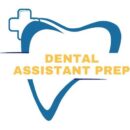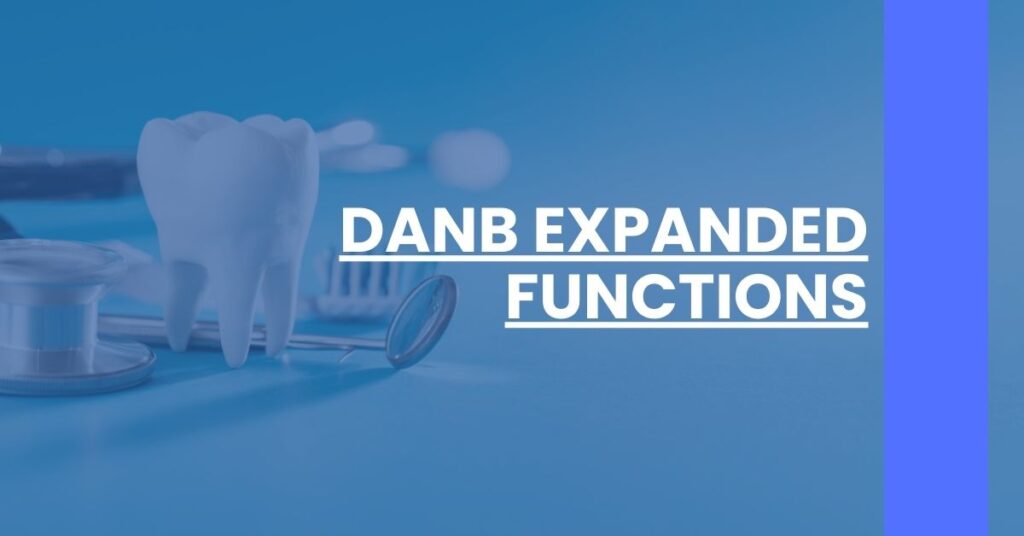DANB Expanded Functions refer to the additional procedures dental assistants can perform after obtaining specific qualifications.
These advanced skills range from applying sealants to taking impressions and can significantly enhance a dental practice’s efficiency and patient care.
Here’s what you’ll gain insight on:
- Qualification prerequisites for performing expanded functions
- List of specific procedures that define expanded functions
- Impact on dental practices and workflow optimization
Perfect for dental assistants aiming for professional growth, this article guides you through the journey of acquiring DANB certification for expanded functions.
What Are Expanded Functions in Dentistry?
As a dental professional, you’re likely aware that the scope of practice for dental assistants can extend beyond the traditional roles of chairside assisting and basic patient care. This is where the concept of expanded functions comes into play, offering a plethora of opportunities for career advancement and skill enhancement within the dental field.
Expanded functions denote the specialized duties that dental assistants can perform after obtaining additional training and certifications. Unlike routine tasks such as taking X-rays and providing patient education, expanded functions could include more complex procedures such as:
- Placing and finishing composite restorations
- Applying dental sealants
- Taking preliminary impressions for prosthetic fabrication
- Performing coronal polishing
- Applying topical anesthetic
Each of these responsibilities requires a keen understanding of dental anatomy, materials science, and clinical procedures. Achieving proficiency in expanded functions not only broadens your spectrum of capable services but also enhances the quality of care you can offer to patients.
To step into the realm of expanded functions, you’ll need to dive into rigorous training programs aimed at equipping you with the necessary skills. But the journey doesn’t stop there; you must also gain official recognition for your expertise, and this is where the Dental Assisting National Board comes into the picture.
The Role of DANB in Expanded Functions
Imagine earning a badge of honor that proclaims your expertise in performing sophisticated dental procedures—a mark that sets you apart from the rest. That’s precisely the kind of distinction DANB certifications offer.
The DANB is the national gold standard for certification in dental assisting. Achieving DANB certification in expanded functions serves as a testament to your competence and commitment to excellence in dental care. Holding such credentials can invariably elevate your professional stature, opening the door to career opportunities that demand a higher skill set.
DANB exams are meticulously crafted to assess your knowledge and ability to safely and effectively perform expanded functions. They’re recognized across numerous states, making the DANB certification a versatile and powerful addition to your professional toolkit. As you strive to attain such qualifications, remember that the trust and recognition that come with a successful certification can significantly impact your career trajectory.
Qualifications for DANB Expanded Functions
Entering the world of expanded functions is much like embarking on a challenging yet fulfilling educational journey where the destination rewards you with professional gratification. Before you can proudly bear the title of an Expanded Function Dental Assistant (EFDA), there are certain qualifications you need to meet. These typically include:
- Completion of an accredited dental assisting program, which may be your stepping stone toward becoming a competent dental assistant.
- Accumulating work experience in a dental setting, allowing you to practice and refine your hands-on skills.
- Passing DANB’s certification exams, such as the Certified Dental Assistant (CDA) exam, which covers the comprehensive skill set expected of an assistant.
Depending on your state’s regulations, you might also need to complete a specific program focused on expanded functions. This structured educational path ensures that you are sufficiently prepared to deliver exceptional dental care while adhering to the highest safety standards.
Types of Expanded Functions Dental Assistants Can Perform
As you venture further into the world of expanded functions, it’s crucial to familiarize yourself with the menu of procedures that you could potentially master. Consider this your playbook, an outline of the expanded skills that can serve patients’ specific needs and amplify the efficiency of the dental practice you support.
While the list of expanded functions might vary by state, here are some of the pivotal services you could be authorized to provide:
- Direct restorations: Placing, sculpting, and finishing amalgam and composite restorations.
- Indirect restorations: Fabricating temporary crowns and bridges.
- Preventive care: Applying fluoride treatments and pit and fissure sealants to protect teeth against decay.
- Orthodontic procedures: Assisting with the placement and adjustment of braces and other orthodontic appliances.
- Oral surgery assistance: Providing pre- and post-operative care, as well as supporting oral surgery procedures.
Delving into these procedures will not only enhance your ability in providing diverse dental care but also empower you to contribute significantly to the well-being of patients. The expertise gained through expanded functions can be incredibly satisfying as you witness firsthand the positive impact of your work on oral health outcomes.
This list of expanded functions provided by DANB can serve as a detailed guide to the full spectrum of tasks you might encounter and provides an excellent starting point for understanding what could lie ahead in your professional journey.
State Variations in Expanded Functions
Your journey toward becoming a dental assistant adept in expanded functions may have a different roadmap depending on where you practice. Just as each state has its own charm and character, they also have distinct regulations regarding what expanded functions a dental assistant can perform.
Let’s contemplate the variety of dental landscapes across the United States. In some states, you might be able to perform a broad range of procedures like direct and indirect restorations, while in others, the scope might be limited to preventive services. The certification requirements, too, transform state by state, with some mandating completion of state-approved educational programs, and others requiring you to hold a national certification such as the CDA from DANB.
It’s critical to be well-informed about your state’s specific guidelines. Not only does this ensure your compliance with legal standards, but it also serves to protect the well-being of patients and uphold the reputation of the dental profession.
If you’re curious about your state’s stance on expanded functions, resources like State Laws on Dental Assistants offer a comprehensive breakdown of the regulations that govern dental assisting practices. By staying updated and adapting to these regulations, you can smoothly navigate your career progression while staying within the bounds of the law.
The Path to Earning Expanded Functions
Navigating the path to earning your credentials for DANB expanded functions can be likened to climbing a mountain: it requires preparation, endurance, and a clear vision of your end goal. Here’s a blueprint to guide you through this ambitious climb:
- Education: Start with a foundation in dental assisting by enrolling in an accredited program. This equips you with both theoretical knowledge and practical skills.
- Experience: Gain hands-on experience in a dental office. This is where you hone your competencies and understand the intricacies of dental care.
- Certification: Choose the DANB exam that aligns with your desired expanded functions. Prepare diligently, as this is a crucial step in obtaining official recognition.
- Legal Requirements: Ensure you meet the state-specific guidelines by checking with your state’s dental board or referring to comprehensively compiled resources like the Dental Assistant State Requirements Snapshot.
- Continued Learning: Stay abreast of evolving practices and refresh your skills through continued education, which is often mandated to maintain your certification.
Embracing this journey not only sets you apart in the field but also empowers you to provide exceptional dental care enhanced by your advanced skills. Once you earn the title of an Expanded Function Dental Assistant, you become an invaluable asset to any dental practice team.
Impact of Expanded Functions on Dental Practices
When you expand your capabilities as a dental assistant, you’re not just elevating your own practice—you’re also revolutionizing your workplace. Integrating expanded functions within a dental practice leads to a fundamental transformation in how patient care is delivered and managed. Here are a few ways your advanced skills can make waves:
- Efficiency Boost: By conducting certain procedures yourself, you’re freeing up the dentist to focus on more complex treatments, optimizing the practice’s schedule.
- Enhanced Patient Experience: With you being able to perform a wider range of tasks, patients enjoy a seamless treatment process, often completed more rapidly and with fewer appointments.
- Team Dynamics: Expanded functions allow for a more collaborative environment where each team member plays a pivotal role, fostering a space for mutual professional growth.
Embrace the influence you can have on your dental practice. Your expanded skills don’t just shape your career—they can reshape the entire landscape of the dental services you provide.
Continuing Education and Maintaining Competency in Expanded Functions
The world of dental technology and practices is ever-evolving, and so should your repertoire of skills. Continuously upscaling your proficiencies in DANB expanded functions is not just recommended—it’s often required to maintain your certification and ensure that you are providing the safest, most up-to-date care.
Enrolling in continuing education courses and staying connected with professional communities allows you to:
- Keep Current: Update your skill set with the latest advancements in dental care.
- Meet Legal Standards: Fulfill state requirements for periodic certification renewal.
- Inspire Confidence: Reassure patients and colleagues of your dedication and expertise.
Just as a craftsman sharpens their tools, continue to sharpen your mind and abilities. In doing so, you’ll ensure that your skills never grow dull and that your professional worth continues to climb.
Preparing for DANB Expanded Functions Exams
Preparation for your DANB exams should be both thorough and strategic. Think of these resources as your study group—there to guide and support you along the way:
- EFDA Practice Test: An invaluable resource for acquainting yourself with the real exam format (Expanded Functions Practice Test).
- Study Guides: Make use of comprehensive guides that cover specifics of the exams.
- Review Courses: Consider enrolling in review courses that provide in-depth insights into the subject matter.
- Peer Study Sessions: Collaborate with peers who are also on the path to certification for mutual support.
By utilizing these preparation strategies, you can approach your exams with confidence, ready to demonstrate your proficiency and step into your role with expanded functions.
Challenges and Opportunities for Expanded Function Dental Assistants
Your journey through DANB expanded functions isn’t without its challenges—navigating state-specific regulations, balancing work with exam preparation, and maintaining poise under the rigors of more complex tasks. However, with these challenges come boundless opportunities.
Expanding your functions not only opens the door to new career possibilities but also places you in a position to make meaningful contributions to the dental health community and the patients you serve. Stay informed on the latest dental workforce trends and look for gaps you can fill with your advanced skills. The industry’s need for specialized dental professionals marks an upsurge in opportunities you don’t want to miss.
Conclusion: The Future of Expanded Functions in Dental Assisting
As we round off our comprehensive glimpse into the world of DANB expanded functions, you stand at a crossroads with the opportunity to forge a future rich with professional fulfillment. The path you’ve embarked upon with expanded functions is not just a testament to your dedication but a jubilant celebration of the potential you hold to impact dental healthcare.
With continued growth, adaptation, and persistence, the proficiency you gain today will blossom into tomorrow’s expertise. There is a horizon brimming with possibilities, and with each step you take, you’re not only expanding your functions but also the horizons of what dental assistants can achieve. The future of dental assisting is bright, dynamic, and awaits your unique contribution.
Go forth with the knowledge that you wield a powerful influence over the quality of dental care, and remember: by expanding your functions, you’re crafting a future that is not only fulfilling for you but transformative for the entire dental industry.

